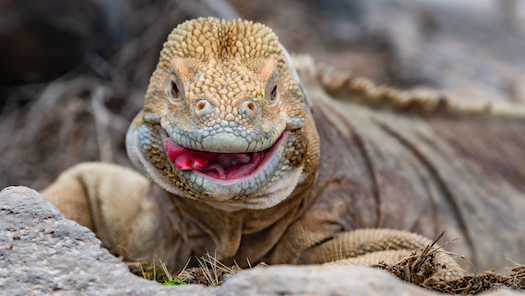
I’m a salty iguana. Normally, I tend to run away from people, but not here. The Galapagos is my home and here people are the visitors. So, pass the poo and let’s have a party. Photo by Dennis Ballesteros
By Teresa Bergen
We’re standing in the equatorial sun on Fernandina Island’s Punta Espinosa, staring at a mostly inert pile of marine iguanas. Occasionally, one shifts position atop another or excretes a hearty burst of concentrated salt from its nasal gland.
Our guide, Danny Moreano, tells us all about their algae-eating habits. He’s been studying animal behavior and leading groups in the Galapagos for twenty years. “When they are not diving under the water, as a way to keep a balance in their diet, you might see iguanas feeding on sea lion poop or other iguana poop,” he confides. “Sea lion poop is a very important part of the iguana diet. Since sea lions eat a lot of fish, it’s a very good source of calcium carbonate.”
Lizard Lovers Welcome
For lizard lovers like me, going on a Hurtigruten Expeditions cruise in the Galapagos is a dream trip. Those expecting the Love Boat may be in for a disappointment. Instead of intimate interludes at the bar with exotic strangers, prepare for lectures on sea lion poop. Truthfully, this famous bucket list trip is not for everybody.
If you don’t like natural science and wildlife and don’t have a high tolerance for quiet nights and early mornings, save your money and go on a big ship Caribbean cruise. But if you want to spend your days delving into volcanic activity, conservation and the surprisingly torrid lives of placid-looking wildlife, go to the Galapagos.
How to see the Galapagos
You have two choices when visiting the Galapagos. You can sign up for a cruise, or you can fly into one of two airports and arrange activities on your own.
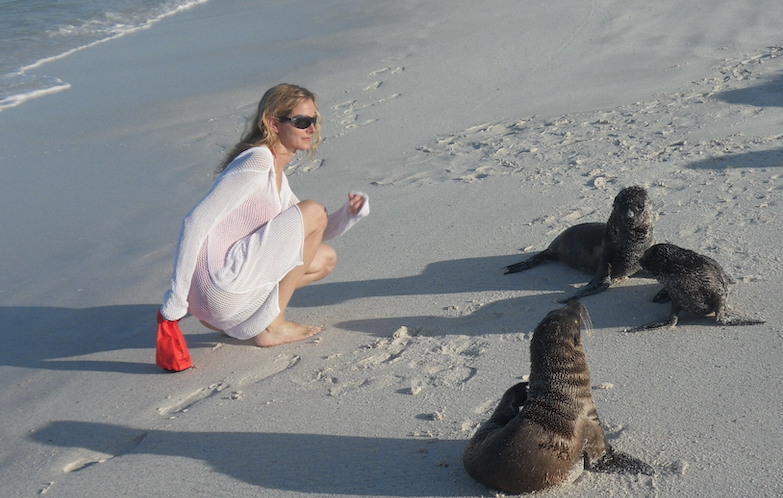
Approach a sea lion on a wharf in San Francisci and you may be bitten. In the Galapagos, animals seldom attack because people aren’t allowed to attack them. Photo by Teresa Bergen
In the last 15 or so years, land-based tourism has grown in the Galapagos, while fewer people are choosing to cruise. But the Galapagos are not a place for independent travelers to roam free. Ninety-seven percent of the land belongs to Galapagos National Park, and you must have a guide to visit the park.
If you do decide to arrange things on your own, the easiest way is to fly into the larger airport on Baltra and take a water taxi to Puerto Ayora. This town of 12,000 is the most populated in the Galapagos. Stay at the upscale Finch Bay Hotel, which will arrange your tours to other islands on its yacht. Or visit the main tourist strip, with dozens of storefronts where you can arrange lower-cost island-hopping. There’s also a smaller airport on San Cristobal in the town of Puerto Baquerizo Moreno (pop. 6,000), the capital of Galapagos province, which also has touring opportunities.
I’ve gone to the Galapagos twice, both times on cruises. The first time was with Ecoventura, and more recently with Hurtigruten Expeditions. The government tightly controls ship-based tourism, capping berths at 100 per ship. The national park limits how many people can visit sites on which islands, doling out time slots so that they are never very crowded. Joining a cruise seems much easier because you don’t have to arrange your guides. The ship travels at night so you can visit more remote islands than you could if you were just doing day trips from a hotel, and your guides and crew do all the work.
Galapagos wildlife activities
In addition to having to love natural science, a Galapagos cruise requires a higher level of physical fitness than you’ll need on many larger cruise ships. Don’t expect elevators onboard. Also, you’ll have to be able to get on and off Zodiac boats. The crew will assist you, but that little rubber boat may be rocking. One day, we had four separate roundtrips in Zodiacs.
Wildlife watching is the main Galapagos activity. Hurtigruten guests look for what the staff terms “the Big 15.” In Africa, the famous Big 5—lion, leopard, rhino, elephant, African buffalo–are all large land animals. The Galapagos’ Big 15 are birds, reptiles and marine mammals. In one single Zodiac ride, we saw six of them all in one place: Galapagos penguins, sea lions, fur seals, marine iguanas, blue-footed boobies and flightless cormorants.
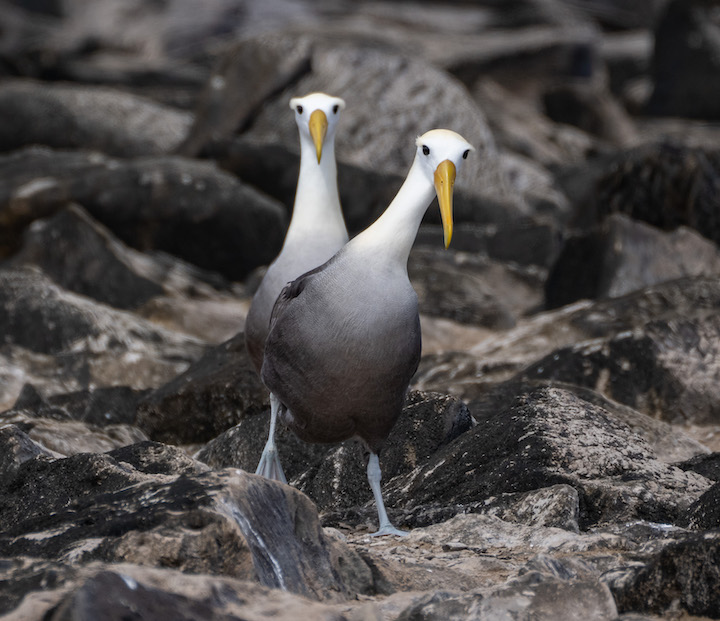
The Galapagos Albatross is a curious bird, cautious at first, but easily approachable once your good behavior is established. Photo by John Chardine
Different landscapes, different animals
The oldest of this volcanic chain of islands is about five million years old, while the newer, more western islands may have formed only 700,000 years ago. Some are flatter, all-black volcanic rock and scrubby red and gold bushes. Others have more nuanced geography, such as Santa Cruz Island where giant tortoises make their homes amid the lush greenery at higher elevations.
Birders especially love the Galapagos, as most of the land birds are endemic, meaning you won’t find them anywhere else in the world (outside of zoos). Six types of seabirds – the Galapagos penguin, flightless cormorant, waved albatross, Galapagos petrel, lava gull and swallow-tailed gull—are also endemic. On my cruise with Hurtigruten, you could always find a few people up at dawn, scanning land and sea with their binoculars. People come for the wildlife. On our one day when we had free time in Puerto Ayora, almost everybody returned to the ship early. Nothing wrong with the town—it has shops, restaurants and my favorite, a Catholic church with stained glass windows depicting Galapagos animals—but human culture isn’t the point of the trip.
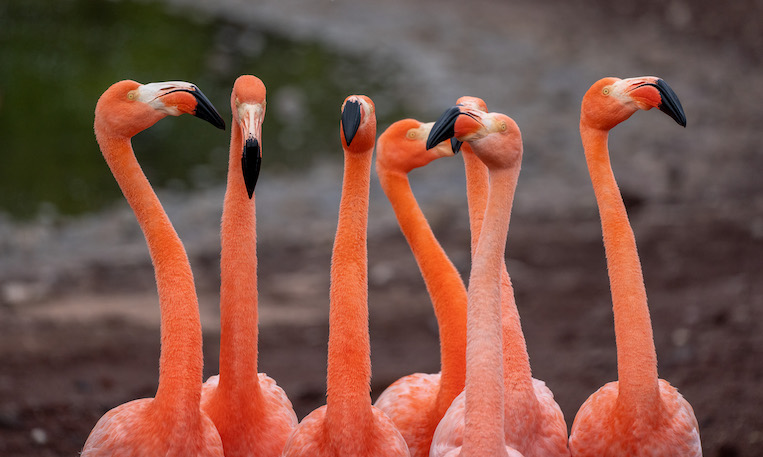
Galapagos Flamingos have a regal posture and often seem as if they are in charge. But any bird completely lacking in all camouflage has to have a bit of attitude. Photo by John Chardine
The Eroticism of Natural Science
At Cerro Dragon, or Dragon Hill, on Santa Cruz Island, we walked along an easy trail, looking for land iguanas digging their burrows. We also saw flamingos stalking pinkly in a brackish lagoon. These nature walks usually consisted of moving twenty feet and then listening to a guide’s informative monologue. Often, they got a bit racy. “Once the male finds a female, the male starts moving his head up and down, bobbing his head like this,” Moreano demonstrated as a big golden land iguana stared back at us. “And every time the male is doing that, he’s also doing some circles around the female body.” The details got increasingly more explicit. Again, you really need to like natural science to enjoy this cruise.
Much of the info is superfluous, but it’s important to nature lovers who want to understand the current state of the islands. While the Galapagos animals are protected now, pirates and whalers did plenty to mess up the ecosystem. Like bringing over goats, pigs, rats and cats, all of whom have gone feral to varying degrees and destroyed habitat. As we searched the landscape at Cerro Dragon for land iguanas, Moreano bemoaned the damage caused by goats. “When they’re moving around, they eat everything. And the worst part is when they produce urine. It’s very acidic and kills the land and nothing grows there.” The giant tortoise population also suffered when pirates realized the reptiles could survive aboard their ships for up to a year without food or water, providing a ready fresh meat source.
The national park has made many efforts to cull unwanted animals, but they can’t hunt them all. Moreano said the wily goats are known to hide in underground lava tubes to evade their would-be eradicators.
We also had opportunities to get in the water with the marine animals. One morning, we chose between kayaks, stand-up paddle boards or a glass bottom boat to get a close look at the sea life. On deepwater snorkeling trips, we jumped off the Zodiac to find ourselves in a world of sea turtles, sea lions, parrotfish, angelfish and white-tipped reef sharks. The water was a warm 78 degrees, but we all had the option of wearing wetsuits. My trip highlight was snorkeling inches above tens of thousands of black-striped Salema near Champion Rock off Floreana Island, a noted dive site. I felt like an oversized member of the school of these five-inch-long fish.
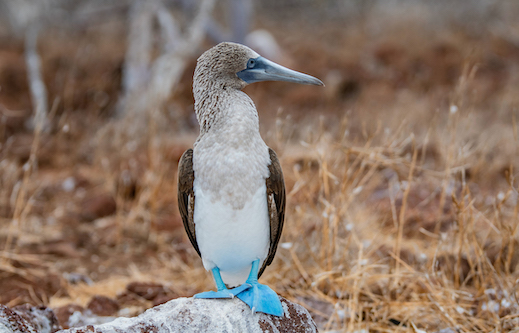
Blue-Footed Boobie is native to the Galapagos. Photo by Dennis Ballesteros
If you didn’t get enough wildlife lectures on land, there were more chances for “eco moments,” short natural science talks, on the boat. The one where I learned that sea lions were descended from bears blew my mind. But one of my fellow passengers found it one of the most boring 15 minutes of his life. Again, know thyself before shelling out for a pricey Galapagos cruise.
Rising Tourism and the Galapagos Economy
When Ecuador first claimed the Galapagos in 1832, two years after becoming independent from Spain, nobody wanted to live on these bleak islands 600 miles off the coast. So, in the long worldwide tradition of island development, the government sent prisoners. Just over a century later, in 1934, the first tourists arrived. By 1978, the year UNESCO granted the Galapagos Islands World Heritage Site status, more than 10,000 visitors were visiting per year.
Numbers continued to rise steadily, and really boomed after 2000, when the islands got phone and internet connections that made it possible to directly book internationally. By 2007, the Galapagos had made it onto the newly developed List of World Heritage Sites in Danger. After the islands instituted fishery controls, biosecurity measures and limiting the number of arrivals by ship and plane, UNESCO removed the Galapagos from the danger list in 2010.
Ever since tourists discovered the islands, the Galapagos have grappled with the push/pull of money and conservation. A study by a group of professors in Ecuador and Montreal concisely framed this common problem among overtouristed sites: “The conservation-tourism alliance contains an inherent paradox: at the global scale, for example, areas considered crucial for biodiversity conservation are designated by UNESCO as Natural World Heritage Sites, but this designation can make them important tourist destinations and can increase pressures on the ecosystem.”
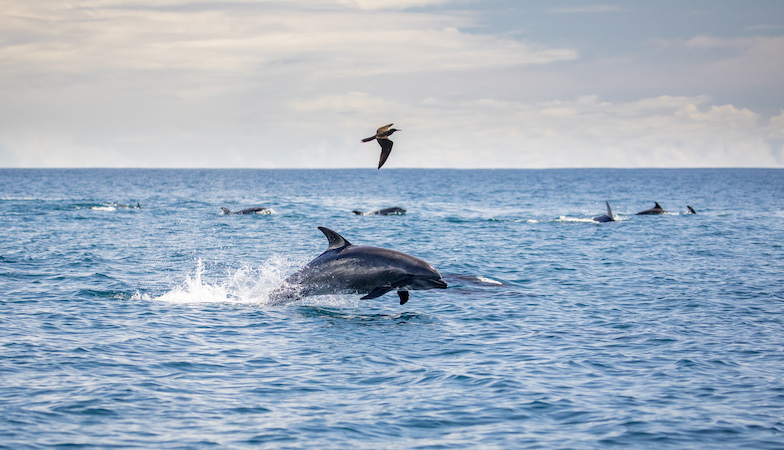
Dolphins swimming off the coast of San Cristóbal Island. Photo by Ashton Ray Hansen
Galapagos National Park charges a $100 entrance fee for foreign tourists—a number which hasn’t changed since 1993. Ecuadorians pay six dollars. One tourism professional told me he thought a fee increase for foreign visitors was long overdue, and that people taking an expensive trip in the Galapagos would barely notice if the fee was increased to $300. According to the Galapagos Travel Center website, 40% of the fee goes to Galapagos National Park and 25% to Galapagos municipalities. The rest gets divided up between Galapagos immigration, provincial government, the Galapagos Marine Reserve, the Ecuadorian Navy and inspection and quarantine services.
Despite the official stand, some locals say the fee has been spent differently over the years. San Cristóbal town council member Gianni Arismendy Guerrero told the website Living Galapagos that island municipalities received more of the fees for community use under former Ecuador President Rafael Correa. Now he said all the money goes through the Ecuador Central Bank, with some of it winding up in other parts of the country.
In addition to the park fee, all visitors pay twenty bucks for a transit control card. Moving to the islands is strictly monitored, and only allowed if you were born there, marry a Galapagos resident or can prove you lived there prior to 1998.
Not too Many, Not too Few
In 2019, 271,000 tourists visited the islands—perhaps too much for the delicate ecosystem. This is a big jump from 1968 when the Galapagos National Park was first established and set the number of tourists at 12,000 per year. Nobody knows exactly how many tourists can safely visit the islands, but obviously more visitors mean more trash and human waste. Increased land-based tourism necessitates transporting more food, building materials and everything else to the Galapagos.
When COVID hit, it halted foreign visits and knocked tourism down by 96% for the first half of 2020. The environment got a much-needed rest. But since tourism makes up 80% of the economy, the residents struggled. Tourism rebounded quickly in this much-beloved destination, with the 2022 numbers just short of 2019. So, the Galapagos continues to try to balance conserving its resources while bringing in money.
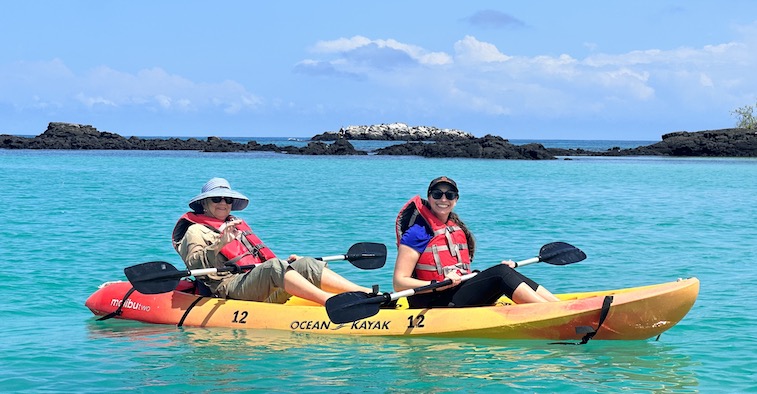
On a Galapagos cruise you’re guaranteed to get wet, salty and sunburned. But nowhere else in the world can you paddle a kayak to see such a wide variety of animals. Photo by Teresa Bergen.
Choose your Cruise
I’d recommend the ease of a floating headquarters for your Galapagos trip rather than staying on land. Both my cruise experiences were excellent. With 90 berths, Hurtigruten Expeditions’ Galapagos ship, the Santa Cruz II, was larger and had more amenities. The ship has two tubs, a large library, bar and shaded outdoor area. I even had a king-size bed. When I traveled with Ecoventura, I was on a smaller ship with a maximum capacity of 22 guests. The food and staff were wonderful, but the amenities were fewer. Both cruises employed fabulous expedition leaders who knew a lot about the natural history of the islands, were good at spotting wildlife and instilled a sense of safety and confidence on our outings. All the crew members I met were from the Galapagos or mainland Ecuador and were happy to talk about life on the islands.
Besides your choice of a small or smaller ship, the most important factor in choosing a Galapagos itinerary is probably which animals you want to see. On my Ecoventura cruise, I visited some of the eastern islands and had better sightings of land iguanas, frigatebirds and blue-footed boobies. While on Hurtigruten’s new western island itinerary, I saw flightless cormorants, Galapagos penguins and fur seals. You’ll need to carefully check a list of island wildlife against possible itineraries if there’s a certain animal you want to see.
But don’t be like the woman one of my Hurtigruten guides mentioned, who said she was so thrilled to be in the Galapagos because she’d always wanted to see a Komodo dragon. A little research now will save you disappointment later.![]()
Teresa Bergen is a Portland, Oregon-based travel writer who specializes in the outdoors. Her favorite Galapagos animal is the marine iguana. She’s previously written about cemetery tourism and traveling to the Arctic Circle.

